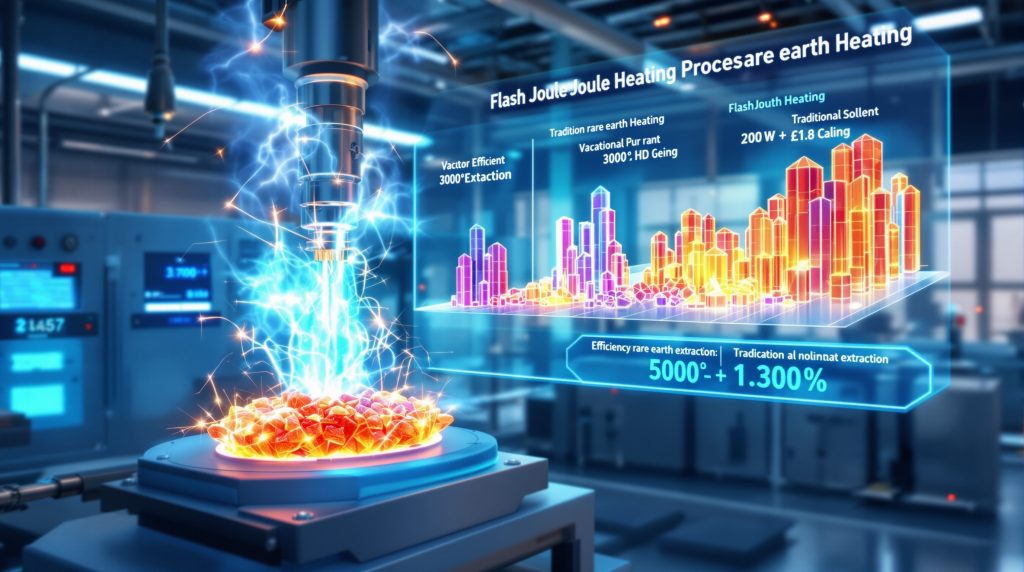Flash Joule Heating Technology: Revolutionizing Rare Earth Element Processing
What is Flash Joule Heating Technology and How Does it Work?
Flash Joule Heating (FJH) represents a groundbreaking electrothermal process that rapidly heats materials to temperatures approaching 3,000°C within milliseconds using controlled electrical pulses. This revolutionary technology works by:
-
Applying intense electrical current through target materials
-
Creating near-instantaneous temperature spikes that break chemical bonds
-
Enabling the separation of elements that would otherwise remain bound together
-
Vaporizing and recovering valuable metals in a single processing step
Unlike conventional methods, FJH creates distinctive thermal responses in different elements, allowing for more efficient separation without extensive chemical processing. The technology's ability to reach extreme temperatures in milliseconds creates unique separation opportunities that traditional methods cannot achieve.
Why is Flash Joule Heating Transforming Rare Earth Processing?
The Critical Limitations of Traditional Methods
The rare earth element (REE) industry has long been hampered by solvent extraction, the conventional separation process that presents multiple challenges:
-
Requires hundreds to thousands of repetitive chemical steps
-
Consumes massive volumes of acids, bases, and solvents
-
Creates significant environmental hazards through toxic waste generation
-
Demands substantial capital investment (often $100M+ for processing facilities)
-
Takes years to reach stable operational capacity
-
Concentrates nearly 90% of global processing capacity in China
These limitations have created a processing bottleneck that threatens global supply chains, with manufacturers like Ford and Suzuki previously experiencing production disruptions due to export restrictions. Furthermore, these challenges highlight the need for critical minerals energy security in developing alternative processing methods.
The Competitive Advantages of Flash Joule Heating
FJH technology offers transformative benefits compared to traditional solvent extraction:
| Processing Factor | Solvent Extraction | Flash Joule Heating |
|---|---|---|
| Processing Time | Days to weeks | Minutes to hours |
| Environmental Impact | High (toxic chemicals) | Minimal (primarily electrical) |
| Energy Efficiency | Low | High |
| Capital Requirements | Extremely high | Moderate |
| Scalability | Limited by facility size | Modular and flexible |
| Geographic Flexibility | Restricted by regulatory environment | Deployable in various locations |
The technology's ability to process materials rapidly with minimal environmental impact positions it as a potential game-changer in critical mineral supply chains.
How Does Metallium's Flash Joule Heating Technology Work in Practice?
The Technical Process Breakdown
The FJH process follows several distinct stages:
-
Material Preparation: Source materials containing rare earth elements are prepared for processing
-
Electrode Placement: The material is positioned between electrodes in a controlled environment
-
Electrical Discharge: A precisely calibrated electrical current passes through the material
-
Flash Heating: Temperature rises to nearly 3,000°C within milliseconds
-
Bond Breaking: The extreme heat breaks chemical bonds between elements
-
Element Separation: Different elements respond uniquely to the thermal shock
-
Collection and Recovery: Valuable metals are captured through condensation and collection systems
This streamlined approach eliminates many of the intermediate steps required in traditional processing, potentially reducing both time and cost factors significantly. In addition, companies like Metallium are further collaborating with Rice University to expand the capabilities of this licensed technology.
Key Technical Innovations
The technology incorporates several innovative features:
-
Precision Current Control: Allows for tailored processing parameters based on target materials
-
Rapid Thermal Cycling: Creates unique separation opportunities through controlled heating and cooling
-
Minimal Chemical Requirements: Reduces dependency on hazardous processing agents
-
Modular Design Potential: Enables scalable deployment across different operational contexts
What Are the Economic Implications of Flash Joule Heating Technology?
Cost-Efficiency Analysis
Flash Joule Heating presents significant economic advantages:
-
Reduced Capital Expenditure: Lower infrastructure requirements compared to solvent extraction plants
-
Decreased Operating Costs: Minimal chemical inputs and reduced waste management expenses
-
Faster Time-to-Market: Accelerated processing timelines improve cash flow dynamics
-
Flexible Scaling Options: Modular design allows for incremental capacity expansion
These factors combine to potentially lower the economic barriers to entry in rare earth processing, creating opportunities for diversification of the global supply chain and providing significant mineral beneficiation insights for emerging economies.
Market Disruption Potential
The technology could reshape market dynamics in several ways:
-
Enabling viable processing facilities outside China
-
Creating opportunities for smaller, more distributed processing operations
-
Reducing the minimum economic scale for viable rare earth processing
-
Supporting the development of circular economy models through e-waste recycling
What Environmental Benefits Does Flash Joule Heating Offer?
Sustainability Advantages
The environmental profile of FJH technology represents a significant improvement over conventional methods:
-
Reduced Chemical Usage: Minimizes dependency on environmentally harmful solvents and acids
-
Lower Water Consumption: Decreases the substantial water requirements of traditional processing
-
Minimal Waste Generation: Produces significantly less hazardous waste requiring treatment
-
Improved Energy Efficiency: More direct energy application reduces overall consumption
-
Smaller Physical Footprint: Requires less land area for equivalent processing capacity
These advantages align well with broader industry trends toward mining decarbonisation benefits and sustainable resource development.
Circular Economy Applications
The technology shows particular promise for recycling applications:
-
Enables efficient recovery of rare earths from electronic waste
-
Creates viable pathways for processing lower-grade materials
-
Supports closed-loop material systems in manufacturing
-
Reduces dependency on primary mining operations
What Challenges Must Flash Joule Heating Technology Overcome?
Technical Hurdles
Despite its promise, several challenges remain:
-
Scaling Consistency: Ensuring laboratory results translate to commercial-scale operations
-
Element Selectivity: Refining the process to target specific high-value elements
-
Material Variability: Adapting parameters for different input compositions
-
Quality Control: Maintaining consistent output purity across processing batches
Commercial Implementation Barriers
The path to widespread adoption faces several obstacles:
-
Industry Conservatism: Resistance to new technologies in established processing sectors
-
Regulatory Navigation: Securing approvals for novel processing methods
-
Integration Challenges: Connecting with existing supply chain infrastructure
-
Market Acceptance: Establishing credibility for materials processed through new methods
How Does Flash Joule Heating Support Supply Chain Security?
Strategic Resource Independence
The technology offers significant geopolitical advantages:
-
Reduces dependency on China's processing dominance
-
Creates opportunities for domestic processing in consuming nations
-
Supports critical mineral security objectives in Western economies
-
Aligns with policy initiatives to diversify supply chains
The implementation of modern mine planning technology alongside processing innovations like FJH could further strengthen resource security.
Policy Alignment and Support
FJH technology is well-positioned to benefit from government initiatives:
-
Connects with the US Department of Energy's nearly $1 billion funding for REE refining capacity
-
Supports objectives under various critical mineral security strategies
-
Aligns with environmental policy goals for cleaner processing technologies
-
Addresses national security concerns around resource dependencies
What is the Future Development Roadmap for Flash Joule Heating?
Technology Evolution Pathway
The development trajectory likely includes:
-
Continued refinement of processing parameters for different material types
-
Integration with complementary technologies for comprehensive solutions
-
Adaptation for additional critical minerals beyond rare earths
-
Development of specialized applications for high-value niche markets
Commercialization Strategy Components
Successful market implementation will require:
-
Demonstration plants proving commercial viability
-
Strategic partnerships with established industry players
-
Licensing models to accelerate technology adoption
-
Development of modular processing units for flexible deployment
How Can Investors Evaluate Flash Joule Heating Technology Opportunities?
Key Performance Indicators
Investors should focus on several critical metrics:
-
Technical Validation: Independent verification of processing efficiency claims
-
Scaling Milestones: Successful demonstration at progressively larger scales
-
Cost Performance: Documented processing costs compared to conventional methods
-
Strategic Partnerships: Collaboration with established industry participants
-
Intellectual Property Position: Patent protection and licensing potential
These considerations are increasingly important for those seeking investment opportunities 2025 in the critical minerals sector.
Risk Assessment Factors
Important risk considerations include:
-
Technology development timelines and potential delays
-
Competitive response from established processing players
-
Regulatory approval processes and timelines
-
Capital requirements for commercial implementation
-
Market acceptance of materials processed through new methods
FAQ: Flash Joule Heating Technology
What makes Flash Joule Heating different from traditional rare earth processing?
Flash Joule Heating uses rapid electrical pulses to heat materials to nearly 3,000°C within milliseconds, breaking chemical bonds and enabling element separation without the extensive chemical processes required in traditional methods. This approach dramatically reduces processing time, environmental impact, and potentially costs.
Is Flash Joule Heating technology commercially proven?
The technology remains in development stages, with laboratory and pilot demonstrations showing promising results. Commercial-scale implementation is still evolving, with demonstration plants representing the next critical validation step.
What materials can be processed using Flash Joule Heating?
While initially focused on rare earth elements, the technology shows potential for processing various critical minerals, electronic waste, and other materials containing valuable elements that are difficult to separate through conventional means.
How does Flash Joule Heating contribute to environmental sustainability?
The technology significantly reduces chemical usage, water consumption, and waste generation compared to conventional solvent extraction methods. Its electrical basis also creates opportunities for renewable energy integration.
What are the capital requirements for Flash Joule Heating facilities?
While specific figures vary by implementation scale, FJH facilities are expected to require substantially lower capital investment than traditional solvent extraction plants, potentially enabling more distributed processing models.
Further Exploration:
Readers interested in learning more about innovations in rare earth element processing can also explore related educational content, such as the article on Metallium's Flash Joule technology at the company's official website.
Are You Investing in ASX Mining Companies?
Discover how to identify major ASX mineral discoveries before the market with Discovery Alert's proprietary Discovery IQ model, which delivers real-time alerts on significant resource announcements and transforms complex data into actionable insights. Explore why historic discoveries can generate substantial returns by visiting the Discovery Alert dedicated discoveries page and begin your 30-day free trial today.




